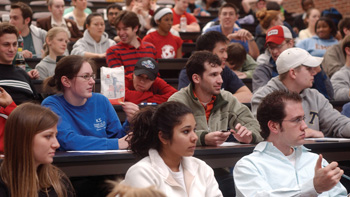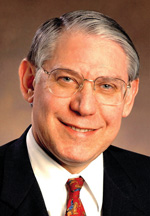
Vanderbilt University School of Medicine is revising its curriculum to help students build the skill sets crucial to practicing medicine in the 21st century. (photo by Susan Urmy)
School of Medicine set to launch revised curriculum

Steven Gabbe, M.D.
Vanderbilt University School of Medicine is launching a major curriculum revision to prepare the next generation of top doctors with modern-day skills in areas including communication, teamwork and information technology.
Curriculum revisions for undergraduate medical students will integrate basic and clinical sciences, adhere to established learning principles and provide students with the skill sets essential to practicing safe, effective, ethical, evidence-based and patient-centered medicine in the 21st century.
“This doesn't happen very often. It is the first time in many decades that we are making expansive changes to our curriculum,” said VUSM dean Steven Gabbe, M.D.
“Certainly the Emphasis program was an important change and we have added courses in nutrition and genetics, but this a big change.”
Students matriculating in August will be the first to experience the new first year. The new fourth-year curriculum will be launched in July.
Changes in the third-year curriculum were instituted last summer, with the addition of intersessions, week-long interludes that provide students the opportunity to explore cross-disciplinary topics such as pain management, communication skills, and preventive medicine.
The second half of each intersession week allows the students to review the basic science concepts pertinent to the clerkship they are about to begin.
Bonnie Miller, M.D., associate dean for Undergraduate Medical Education, said today's doctors need to have outstanding information technology skills. They must know how to frame good clinical questions and how to work with resources to get answers.
“I think the paradigm, or the model, for the great doctors of the 20th century were the doctors who knew the most, who could retain the most information in their brains,” Miller said.
“But the best doctor of the 21st century is going to be one who is not only knowledgeable but also has other skill sets. There is no way you can learn all of the medical information there is to know these days.”
Nearly all VUSM courses have been disciplined-based, but the new curriculum is geared to integrate courses across disciplines in the first two years.
“Instead of an anatomy course and a physiology course, we will have a course called Structure, Function and Development, which will integrate anatomy, physiology, histology, or tissue anatomy, and embryology in a more systems-based approach,” Miller said.
Another important aspect of the new curriculum is the incorporation of active learning methods.
“We have to engage our students and have them elaborate on the knowledge they are trying to learn,” Miller said.
“We want to utilize small group discussions as well as problem-based learning, a method of teaching medicine in which students are presented with patient problems. They define their learning objectives for that problem, find the answers using a variety of information sources, come back to the group and teach what they've found,” she said.
Even lectures can become active learning experiences with the use of technologies such as audience response systems," she said. "We are encouraging our course directors to innovate in these ways."
Third-year Intersessions Course Director Kimberly Lomis, M.D., said the new format allows VUSM to add curricular content in topics that apply to all areas of medical practice but are often not explicitly taught.
Topics, which were chosen by faculty experts and prior students, include women's health, geriatrics, palliative care and medical systems, with shorter blocks in preventive medicine and nutrition.
Lomis said the surgery-specific portion of the intersessions introduced students to techniques important in examining patients who are in pain, whereas most of their prior experience in Physical Diagnosis did not include interacting with patients in acute distress.
“We worked with the Center for Experiential Learning and Assessment to develop standardized patient experiences,” she said.
“The students commented that these scenarios were quite realistic and helped them practice comforting and assessing such patients prior to starting on the wards.”
Miller said the changes have received excellent feedback from students.
“About 70 percent either agreed or strongly agreed that the intersessions were very helpful,” she said.
“And we received some excellent comments from students about how to improve the intersessions in the future.”













